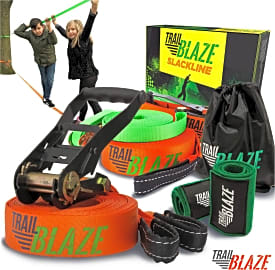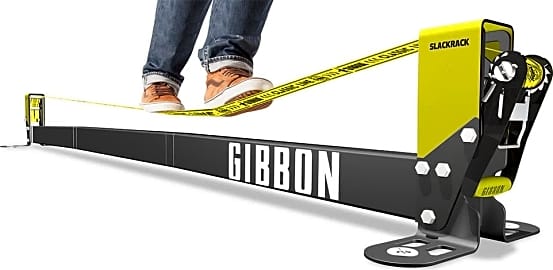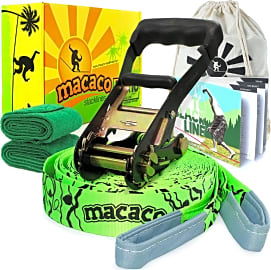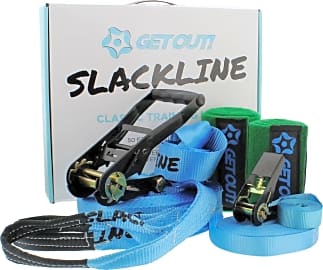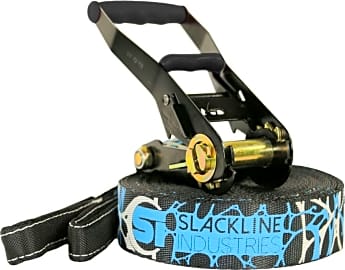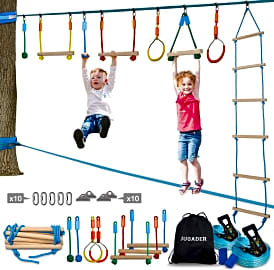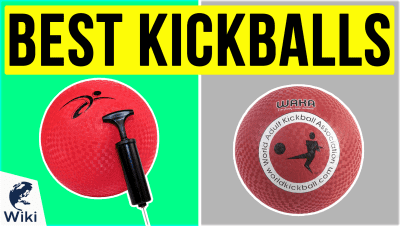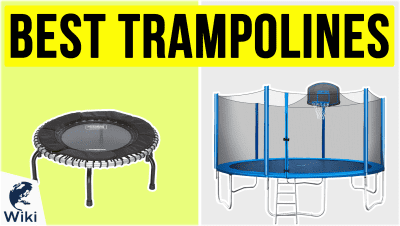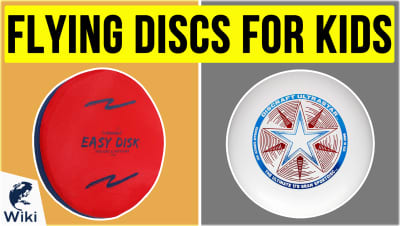The 10 Best Slacklines

This wiki has been updated 39 times since it was first published in September of 2015. If you have ever watched an acrobat walk a tightrope and wished you could accomplish a similar feat, one of these slacklines should be on your shopping list. While we can't guarantee they'll turn you into a modern-day Charles Blondin, they can help improve your balance, concentration, core strength, and posture. We've included models suitable for both novices and experts. When users buy our independently chosen editorial recommendations, we may earn commissions to help fund the Wiki.
Editor's Notes
July 09, 2020:
If you're trying to get your adrenaline pumping, there are plenty of sports that can succeed in doing this. Heck, I remember how excited I used to get in grade school before a scheduled kickball game. I loved the feeling of kicking one of those colored rubber balls to the opposite end the schoolyard and being able to make it back to home plate before the opposing team could retrieve it. Granted, that's a sport played on level ground. In those days, I never imagined that people would want to imitate a tightrope walker at the circus. Little did I know that doing so could provide a ton of benefits when it comes to strengthening core muscles, concentration, and balance. Our list of slacklines can be used by kids and professional athletes alike.
The Flybold Complete comes with dedicated training lines for both your feet and arms, so you can learn how to balance and position yourself for success.
For the advanced athlete looking to improve their coordination and/or acrobatic skills, the trampoline-style webbing on the Slackline Industries Aggro provides adequate bounce for performing a variety of tricks while suspended. The 50-millimeter main line on the Macaco Complete is also good for this purpose.
We've included the Gibbon Slackrack as testament to the fact that slacklines don't always have to be suspended between two trees. This standalone option is constructed with a powder-coated metal frame and is ideal for beginners who want to experience the sport and improve their balance from the ground.
New this year is the Gibbon Flow Line, which sports a two-toned webbing that makes it easy to distinguish the front side from the back, so you can correct any twists when setting it up over long distances.
Finally, we wanted to add something designed exclusively for kids, so the Jugader Ninja Line fills that niche. This one essentially marries the benefits of an obstacle course with a slackline to help kids develop their sense of balance and coordination.
Special Honors
Slackline U.S. Slackline U.S. is a nonprofit organization that assists in access management for the slackline community, encouraging conservation, and fostering safe practices in all forms of the sport. Through education and community development, the organization helps consolidate gear and rigging knowledge, publish conservation guidelines, organize clean-ups and trail building projects, and coordinate efforts of local groups through outreach programs and connections with the International Slackline Association, of which it is a founding member. Membership also includes access to gear discounts. slackline.us
Break From The Norm: Slackline It
To have a confident feeling of the body's sense of its position in space can serve to prevent muscle injuries, while also strengthening the spine, back, and stomach muscles.
There's nothing wrong with conventional exercise like running, jogging, sit-ups, swimming, etc. Virtually every form of exercise requires some degree of will power, stamina, and training. To take this a step further, many consider exercise to be an art form and a special religion in and of itself. That said, what if you decided to break from traditional orthodoxy and try something that you wouldn't ordinarily consider to make use of all your muscles, while improving your balance and concentration all at the same time? Welcome to the world of slacklining.
Slacklining is a unique type of exercise that involves walking or balancing along a suspended length of flat webbing that is tensioned between two separate anchors. At first, you might think slacklining is just like tightrope walking; the type of spectacle you would expect to see at the circus.
The main differences between tightropes and slacklining are observed in the type of materials used for the rope or webbing as well as the degree of tension applied to the material. Slackline webbing is usually tensioned to a lesser degree than tightrope material. With less tension, a slackline provides a dynamic line capable of stretching and bouncing in the air, similar to the way a trampoline might operate. However, the degree of tension in slackline webbing is still adjustable.
A slackline can be set up with either two or three sections of webbing along with a tensioner. With a two-section slackline, one long piece of webbing (usually between thirty and one hundred feet long and a couple of inches thick) with a sewn-in loop on one end will wrap tightly around a tree. The second section of webbing (typically around ten feet long) has a similar loop on its longer end, which wraps around another tree, while its shorter end is sewn to a ratchet. The ratchet allows these two sections of webbing to stay connected, while allowing the user to adjust the tension of the webbing to the desired specifications. In a three-section setup, the same long piece of webbing is tightly-strung and connected to two shorter sections (around eight to twelve feet each) called tree slings, which act like anchors on either end.
Trees are the most common anchor for slacklines. This would make sense considering slacklines are kept low to the ground, so tree trunks make it fairly easy to wrap flexible webbing around them to create ample support for tensioning. Trees with a diameter of twelve inches or more are ideal for slacklining.
It's also useful to note that this activity has different manifestations that include urbanlining, tricklining, waterlining, and highlining, but the fundamental purpose of each variation is quite similar.
Finally, slacklining is beneficial in a number of ways. It improves concentration, balance, and posture. Some slackliners also use the activity as a way to clear their minds as a form of mid-air meditation. Slacklining is even recommend by medical professionals for its ability to improve both proprioception and coordination. To have a confident feeling of the body's sense of its position in space can serve to prevent muscle injuries, while also strengthening the spine, back, and stomach muscles.
A Brief History Of Slacklining
Although rope walking has been around for thousands of years, the origin of modern slacklining is attributed to southern Illinois rock climber Adam Grosowsky; son of the head of the design department for Southern Illinois University. Adam became incredibly interested in a photo he discovered at the university library depicting a circus performer doing a one-hand handstand on the top of a flagpole. Fascinated with circus performing and setting out to recreate this image, Adam reached out to a small group of local climbers and tried to encourage them to perform the same amazing act. Out of everyone in this group, Adam was the only one to succeed in doing a handstand on one-inch webbing, even while the webbing rocked from side to side.
In 1979 at The Evergreen State College, Grosowsky met two additional climbers named Jeff Ellington and Brooke Sandahl. Having set up a highwire in the woods on campus, the three climbers worked tirelessly to perfect their walking, handstands, and other tricks atop the nylon webbing. This webbing provided the group the flexibility needed to attempt other circus-style acts, such as a juggling routine between two climbers balanced simultaneously on the same line of webbing.
Slacklining continued to gain popularity in the rock climbing community and spawned many different variations of the sport, including highlining and tracklining.
Be Confident And Safe
If you're new to slacklining, finding one with wide enough webbing and secure anchors is of paramount importance. Some slacklines also have rubber integrated into their design, which provides additional flexibility if you're into bouncing and performing stunts.
If you're just starting out or if you're purchasing a slackline for your kids, then a shorter line will be beneficial for easy balancing. Setting up the slackline at shoulder height and close to the ground is ideal for training and getting your kids used to the sport.
Finally, protecting the tree anchors from bark abrasion is good for the environment. Look for a slackline that includes equipment for secure anchoring with additional protection for the trees being used. For example, some slacklines can be secured to tree anchors using Velcro, which stays in place, while also being gentle on tree bark.


